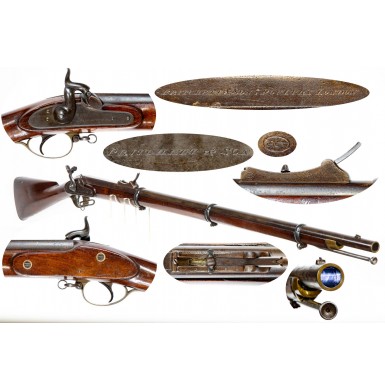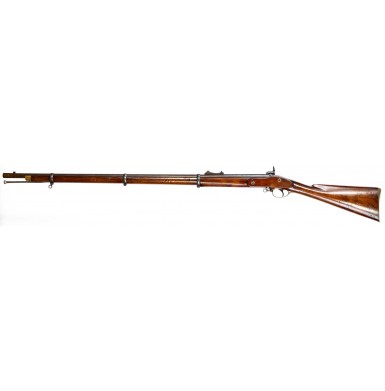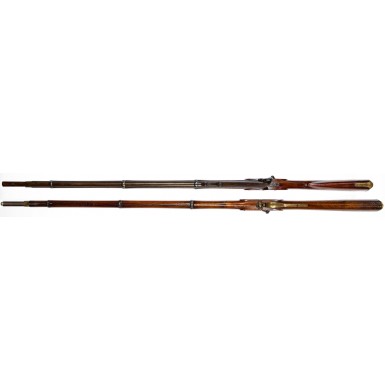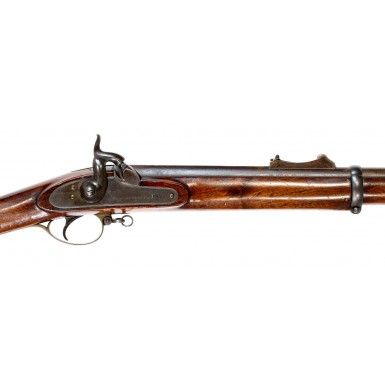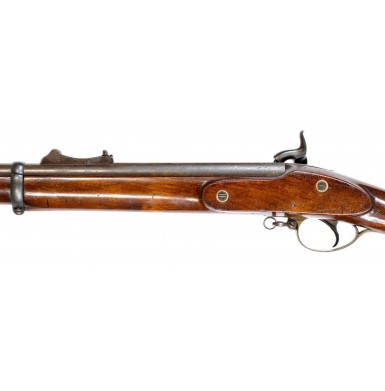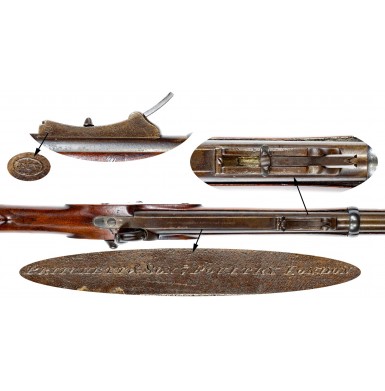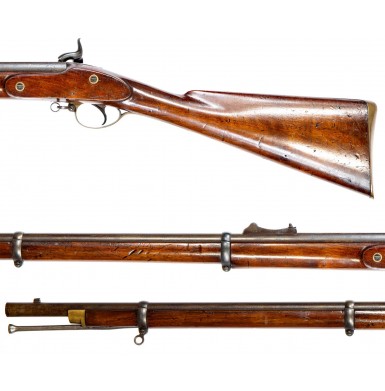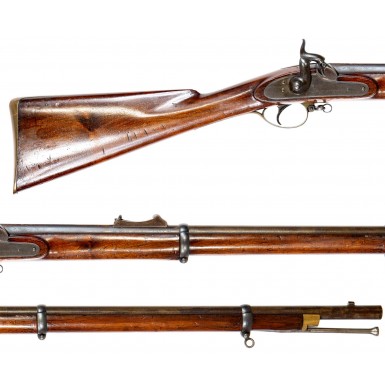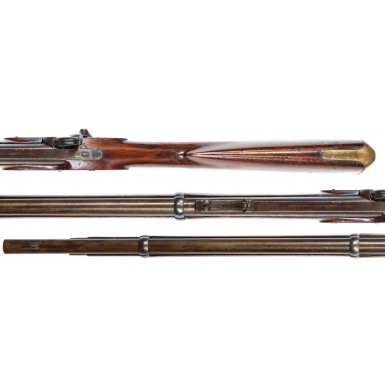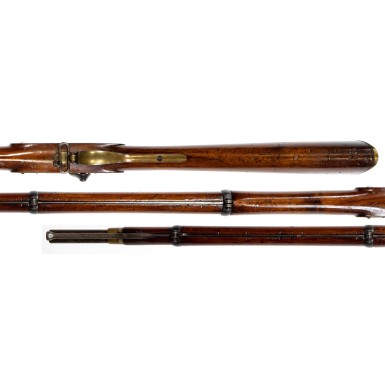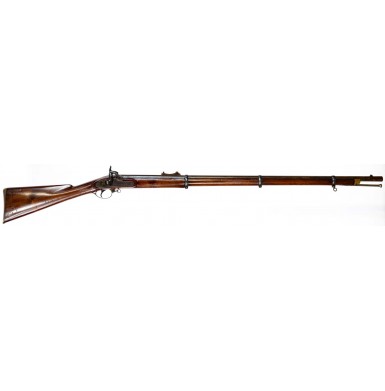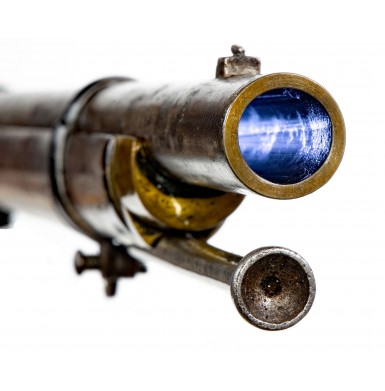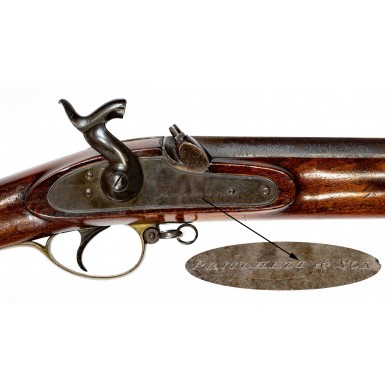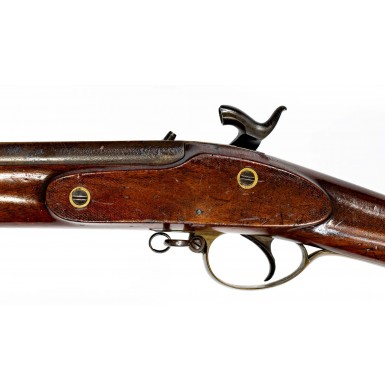Early British Pattern 1853 Enfield Military Match Rifle by Pritchett & Son
- Product Code: FLA-3565-SOLD
- Availability: Out Of Stock
-
$1.00
During the mid-19th century the sport of target shooting was taking the world by storm, and target rifle matches attracted competitors and spectators very much like modern professional sporting events do today. In England, in particular, this fervor for competitive shooting went hand-in-hand with the patriotic “Volunteer” movement that sought to establish a well-trained militia throughout the island nation to help defend the country. The fear was that Napoleon III, emperor during the French Second Empire period (1852-1870) would pick up the mantle of his predecessors and set his sights on invading Great Britain. To this end, the British government encouraged the formation of these patriotic volunteer units to provide the core of a well-trained militia to help repel the feared invasion. These units often competed in local and national shooting competitions, in multiple categories. The primary class was the Military Match Rifle class, which required the use of arms that were essentially of current British military configuration, and in the standard British military .577 caliber. Other classes included small bore rifle matches, that often used rifles like the .451 caliber Kerr Rifle. The Kerr had the advantage of being essentially the same as the standard Pattern 1853 Rifle Musket, but with a different barrel. This allowed the competitor on a budget to purchase a London Armoury Company Pattern 1853 Enfield Rifle Musket and a Kerr barrel from the same firm and be able to compete in two classes by simply changing barrels.
There was a large amount of latitude in the features that were legal on the firearms used in the Military Match Rifle target competitions. Other than the requirement that the gun essentially follow a standard, current military pattern, be able to mount a bayonet and be .577 caliber, almost anything that could enhance the accuracy of the gun was allowed. These features could be minimal, such as checkered stocks to enhance the shooter’s grip on the gun and competition quality locks, often with a fly on the tumbler, an enhanced trigger pull and a highly tuned action. More significant equipment upgrades could include precision adjustable sights and patent rifling patterns in the .577 caliber bores to enhance accuracy. While many competitors relied upon the standard three-groove, progressive depth rifling used on the British military P1853 rifle muskets, various patent rifling patterns by gunmakers like Thomas Turner, James Kerr, Sir Joseph Whitworth. W.E. Metford and Charles Lancaster, to name just a few, all had their supporters and detractors.
Offered here is a nice example of a higher end, British Military Match Rifle by Pritchett & Son of London. The old-time London gunmaking company had its origins with Samuel Pritchett who worked circa 1786-1821. Samuel was free of the Gunmaker’s Company in 1786, took livery in 1795, was elected Assistant in 1796 and subsequently elected Master of the Gunmaker’s Company in 1800 and 1812. He was a contractor to the British Board of Ordnance (1793-1801) and the East India Company (1805-1821). His initial business location was on Swan Street in the Minories the year after he took livery, in 1796. In 1799, he moved to 37 Chamber Street. His son, Richard Ellis Pritchett (1781-1866) was apprenticed to his father in 1795, the very year that his father was allowed to work on his own, rather than for another master gunmaker. Richard Ellis Pritchett was freed of the Gunmakers Company and took livery in 1808 and was elected Assistant that same year. In 1810, he was elected Master. Although he showed his business premises as Prescott Street circa 1812-1813, by 1814 he was located with his father at 37 Chamber Street, where he would remain until 1831. In 1821, his father passed away, and Richard Ellis took over the family business. Richard Ellis was a contractor to the Board of Ordnance as of 1823, and for the East India Company from 1821-1851, likely taking over his father’s East India Company contracts. Richard Ellis had two sons, Richard Ellis II (born 1814) and Robert Taylor (born 1828). Both would take their apprenticeships under their father and eventually enter the family business. Richard Ellis Pritchett moved the business to 59 Chamber Street in 1832, where it would remain for nearly two decades. In 1851, the firm became Pritchett & Son, and over the next few years, the gunmakers operated several different premises simultaneously. His sons Richard Ellis Pritchett II and Robert Taylor Pritchett would become most famous for their invention of the “Pritchett Bullet” that they designed in conjunction with W.E. Metford. This smooth-sided, sub-caliber elongated round nosed bullet was a variant of the French Minié bullet with a hollow base that was expanded by the hot gasses when the gun was fired, and then fit the bore tightly and engaged the rifling in the bore. For their invention of the bullet that became the standard British military bullet design for roughly two decades, Pritchett & Son was awarded £1,000 by the Board of Ordnance in 1854. The father, of this gunmaking dynasty, Richard Ellis Pritchett I retired in 1855 and died in 1866. By 1856 Richard Ellis Pritchett II had retired and the business was left in the capable hands of Robert Taylor Pritchett. Robert was elected a Fellow in the Society of Antiquaries in 1861 and continued the family through 1865, when he retired. Robert had taken up art and found that he had a talent. He provided the illustrations for Scott’s British Army in 1868 and eventually became a private painter of watercolors to Queen Victoria. Robert died in 1907.
This Pritchett & Son Military Match Rifle has features of the earliest of the Pattern 1853 Enfield Rifle Muskets, often referred to by students and collectors of these arms as the Type I Pattern 1853. Most noticeable among these features are the hammer spur with curl on the end that harkens back to the George Lovell designed Pattern 1839, Pattern 1842 and Pattern 1851 long arms. The ramrod also has a small tulip-head and a swelled shank that retains the ramrod in stock. The gun is clearly set up for target and competitive use with a special rear sight that is adjustable with a curved sliding blade that moves along a curved ramped base that is graduated to 700 yards. The rear sight has an illegible makers mark on the right rear sight of the sight wall. The front sight has a musket style base with a semi-Patridge shaped, undercut sight blade with a small bead at the rear. The gun bears minimal external markings, with the lock marked clearly PRITCHETT & SON. The top of the extended nocksform (flat on the top of the round barrel) is engraved:
PRITCHETT & SON 7 POULTRY LONDON
The Pritchett’s worked at the 7 Poultry address circa 1853-1855. The extended nocksform is a feature that is typically only encountered on the earliest, experimental and trials British military Pattern 1853 Enfields, although it can be found occasionally on early commercial arms as well. The only other markings are under the barrel. These include the standard London commercial proof marks of a {CROWN} / V and {CROWN} / GP, the name PRITCHETT stamped twice, the numbers 210 and 2046-1107. The gun measures 54 5/8” in overall length with a 39 1/8” barrel secured by three clamping barrel bands. The gun has a 13 ½” length of pull, and like most P1853s is mounted with brass furniture, including the buttplate, triggerguard and sidenail caps. The iron barrel of this gun was originally browned and the lock color casehardened. The Italian walnut stock has a nice figure and is somewhat slimmer and more streamlined than the standard military stock, but this is subtle and is more noticeable when the gun is handled and mounted than from a visual standpoint. The gun is mounted with a rounded oval sling swivel on the front bow of the triggerguard and a sporting style swivel on the upper barrel band, which is designed to take an English sporting sling with a hook at the end.
The gun remains in about VERY GOOD condition. The barrel has a moderately oxidized bronze-brown patina with even light pitting over all of the metal. The markings all remain clear and legible, even the engraved nocksform, despite this oxidized wear. Under the barrel about 80% of the original browned finish remains intact, where it has been protected by the stock. The lock retains some mottled traces of case coloring on the exterior and about 60% of the vivid colors on the interior. The lock is mechanically fine and crisp and operates correctly on all positions. The rear sight is complete and includes the tension screw that allows the ramped blade to set securely in different positions, this same set screw can double as the rear sight aperture when the ramped blade is not extended. The original front sight remains in place near the muzzle and both sling swivels remain in place as well. The original barrel bands are in place as well, and they retain their tension screws and small screw protecting “doughnuts” that are often missing from the screws of the Palmer Patent bands. The original swelled shank, tulip-head ramrod is in place, it is full-length with good threads at the end. The bore of the gun remains in VERY GOOD condition. It is mostly bright with scattered oxidation, patches of discoloration and some scattered patches of light pitting, most notably near the muzzle area. The brass furniture has a dull, ocher patina that is quite attractive. The stock is in NEAR FINE condition. It remains full-length and solid and is free of any breaks or repairs. The stock has an old applied coat of light varnish that might be from the period of use, and which has certainly protected the stock over the years. The stock does show numerous scattered bumps, dings and mars from handling and use.
Overall this is a very nice example of a scarce, early production Pattern 1853 Type I style Military Match Rifle by one of the more famous of the London gunmakers of the period. A target rifle from the shops of the men who invented the Pritchett bullet is certainly an intriguing item. The gun features some unique features like the ramped rear sight and some very early, Type I Enfield characteristics. Although the metal suffers from poor storage over the years, the gun remains crisp and mechanically fine and would no doubt still do yeoman’s duty on the target range today. This would be a nice addition to any collection of mid-19th century English percussion rifles, whether you collect Enfield pattern rifles or target rifles.
SOLD
Tags: Early, British, Pattern, 1853, Enfield, Military, Match, Rifle, by, Pritchett, &, Son

